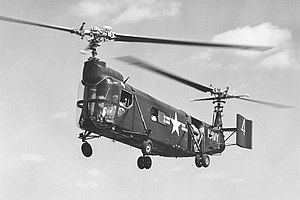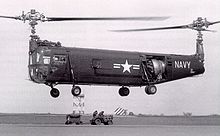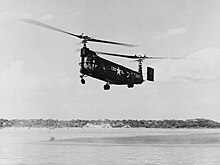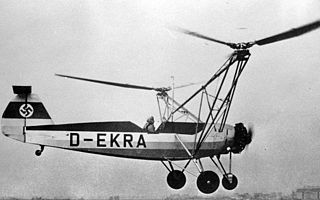
The Focke-Wulf Fw 61 is often considered the first practical, functional helicopter, first flown in 1936. It was also known as the Fa 61, as Focke began a new company—Focke-Achgelis—in 1937.

The North American AJ Savage is an American carrier-based medium bomber built for the United States Navy by North American Aviation. The aircraft was designed shortly after World War II to carry atomic bombs and this meant that the bomber was the heaviest aircraft thus far designed to operate from an aircraft carrier. It was powered by two piston engines and a turbojet buried in the rear fuselage. The AJ-1 first became operational in 1950 and several were based in South Korea during 1953 as a deterrent against North Korea. Of the 140 built, plus three prototypes, 30 were reconnaissance aircraft. Inflight-refueling equipment was deployed on the Savage in the mid-1950s. The bomber was replaced by the Douglas A3D Skywarrior beginning in 1957. The type was used after its military service for some additional experiments including microgravity test flights and to test a new jet engine in the 1960s and 70s.

The Sikorsky CH-37 Mojave is an American large heavy-lift helicopter of the 1950s. This design was a late 20th century military heavy lift helicopter. It was the Sikorsky S-56 and entered service as the HR2S-1 Deuce with USMC in 1956, and the U.S. Army as the H-37A that same year as the H-37A Mojave. In the early 1960s the designation was standardized to CH-37 for both, with the HR2S-1 becoming the CH-37C specifically.

The Bell 212 is a two-blade, twin-engine, medium helicopter that first flew in 1968. Originally manufactured by Bell Helicopter in Fort Worth, Texas, United States, production was moved to Mirabel, Quebec, Canada in 1988, along with all Bell commercial helicopter production after that plant opened in 1986.

The Vought OS2U Kingfisher is an American catapult-launched observation floatplane. It was a compact mid-wing monoplane, with a large central float and small stabilizing floats. Performance was modest because of its low-powered engine. The OS2U could also operate on fixed, wheeled, taildragger landing gear.

The Bell XV-15 is an American tiltrotor VTOL aircraft. It was the second successful experimental tiltrotor aircraft and the first to demonstrate the concept's high speed performance relative to conventional helicopters.

The Bell Helicopter Eagle Eye, Model 918, was an American tiltrotor unmanned aerial vehicle that was offered as one of the competitors in the United States Navy's VT-UAV program.

The Kamov Ka-15 was a Soviet two-seat utility helicopter with coaxial rotors, which first flew on 14 April 1952 at the hands of test pilot D. K. Yefremov. It was the world's first mass-produced coaxial helicopter. State acceptance trials were completed in 1955, and the helicopter entered production the following year at aircraft factory No. 99 in Ulan-Ude. It was a precursor to the Ka-18 and was fitted with the M-14 engine. It was primarily used for bush patrol, agricultural purposes and fishery control.

The Bell 427 is a twin-engine, multirole, light utility helicopter designed and manufactured by Bell Helicopter and Samsung Aerospace Industries. It has been replaced in production by the larger Bell 429.

The Curtiss-Wright X-19, company designation Model 200, was an American experimental tiltrotor aircraft of the early 1960s. It was noteworthy for being the last aircraft of any kind manufactured by Curtiss-Wright.

The Flettner Fl 282 Kolibri (Hummingbird) is a single-seat intermeshing rotor helicopter, or synchropter, produced by Anton Flettner of Germany. According to Yves Le Bec, the Flettner Fl 282 was the world's first series production helicopter.

The Lockheed XH-51 was an American single-engine experimental helicopter designed by Lockheed Aircraft, utilizing a rigid rotor and retractable skid landing gear. The XH-51 was selected as the test vehicle for a joint research program conducted by the United States Army and United States Navy to explore rigid rotor technology.

The MD Helicopters MD Explorer is a light twin-engined utility helicopter designed and initially produced by the American rotorcraft specialist McDonnell Douglas Helicopter Systems.

The Agusta AB.102 was an Italian helicopter produced in small numbers in the early 1960s. The aircraft was based on the mechanical components of a Bell 48 that Agusta incorporated into an all-new, streamlined fuselage. The first flight was on 3 February 1959 and the prototype was exhibited at that year's Paris Air Show in faux military colours. Only two production examples were built, operated by Elivie in a regular air service between Turin and Milan from 1961. However, the advent of turbine-powered helicopters in the 1960s soon rendered the AB.102 obsolete.

The Bell R-12 was an American 1940s military utility helicopter built by the Bell Helicopter company. The design did not go into full production, but over a dozen prototypes were used for various tests and projects.

The Sikorsky S-60 helicopter, a prototype "flying crane", was derived from the S-56 in 1958. Proving to be underpowered, the development of the S-60 led to the larger, turbine-engined Sikorsky CH-54 Tarhe military transport helicopter, and its civil S-64 Skycrane variant, which were already on the drawing board by the time the sole example of the S-60 crashed on 3 April 1961.
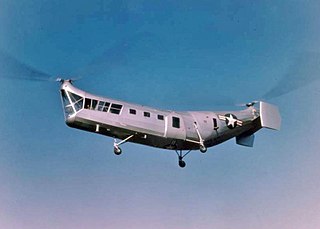
The Piasecki HRP Rescuer is a United States tandem-rotor transport or rescue helicopter designed by Frank Piasecki and built by Piasecki Helicopter. The Piasecki PV-3 was adopted as the HRP-1 Rescuer by the United States Navy, United States Marine Corps, and United States Coast Guard. An improved PV-17 variant was later produced as the HRP-2. As one of the first transport helicopters in military service, the HRP-1 was capable of carrying two crewmen and 8–10 passengers or 2,000 lb. (907 kg) of cargo.

The McDonnell XHJH Whirlaway, aka McDonnell Model 37, was a 1940s American experimental transverse-rotor helicopter designed and built by McDonnell Aircraft Corporation for the United States Navy and was the largest helicopter at the time, as well as the first successful twin-engined twin-rotor helicopter in the world.

The Hiller Ten99 was an American 1961 experimental helicopter, created by Hiller Aircraft.
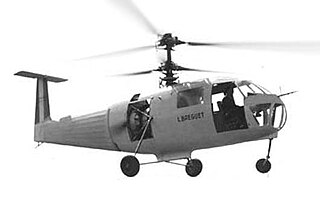
The Breguet G.111 or alternatively, G.11E was a French passenger coaxial rotors helicopter flown soon after World War II. Only one was built, development ceasing when funding ran out.
